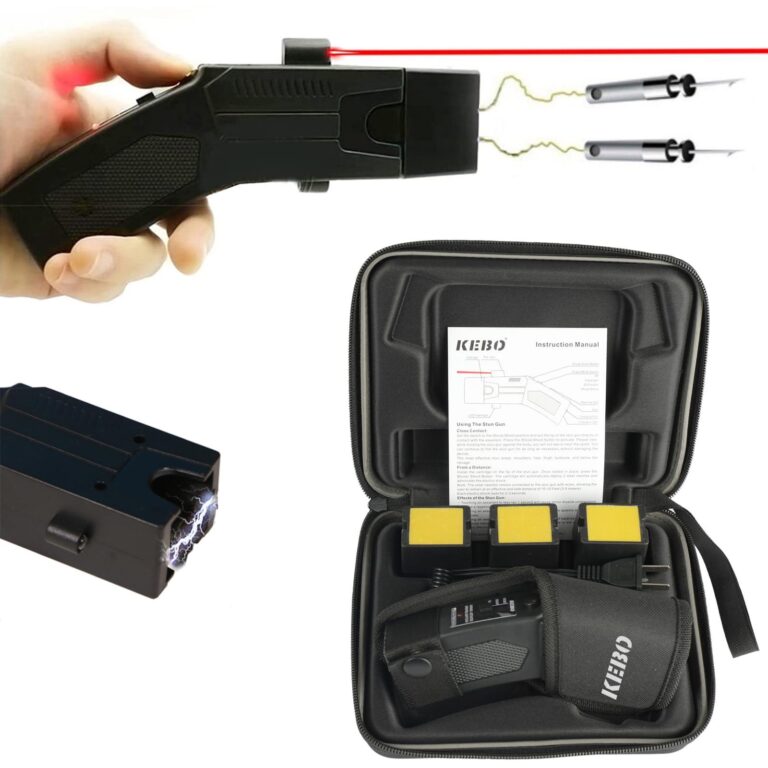Table of Contents
- How Stun Guns Interfere with the Nervous System to Induce Muscle Contractions
- The Science Behind Electrical Pulses and Muscle Response
- Key Factors Influencing the Effectiveness of Stun Guns in Triggering Muscle Contractions
- Best Practices for Safe and Effective Use of Stun Guns in Self Defense
- Future Outlook
How Stun Guns Interfere with the Nervous System to Induce Muscle Contractions
At its core, the effect of a stun gun relies on disrupting the normal flow of electrical signals within the nervous system. These devices emit a sudden burst of high-voltage, low-amperage electrical current that overrides the body’s natural nerve impulses. When this electrical pulse reaches the motor neurons, it causes an involuntary and rapid firing of these nerves. As a result, the muscles receive continuous, conflicting signals that trigger uncontrollable contractions, effectively incapacitating the muscles temporarily. This mechanism is precisely why the device can immobilize a person without causing permanent physical damage.
Several key factors contribute to the stun gun’s ability to manipulate the nervous system:
- Electrical Conductivity: The placement of electrodes ensures efficient transmission of current through the skin and underlying tissues.
- Pulse Frequency and Duration: Electrical pulses are timed to maximize nerve stimulation without causing nerve or muscle fatigue.
- Targeted Neuromuscular Effect: By focusing on motor neurons rather than sensory nerves, stun guns cause immediate muscle contractions while keeping pain signals secondary.
The Science Behind Electrical Pulses and Muscle Response
When an electrical pulse is delivered through a stun gun, it rapidly disrupts the normal electrical signals in the body that control muscle movement. Our muscles contract through the transmission of electrical impulses from the nervous system. These impulses trigger muscle fibers to shorten and produce movement. An external pulse from a stun gun overrides this natural process by sending a powerful, uncontrollable signal, forcing the muscles to contract involuntarily. This sudden stimulation leads to rapid muscle contractions, inducing temporary incapacitation without causing permanent damage.
Several factors influence how these electrical pulses affect muscle response, such as:
- Pulse Frequency and Duration: Short, high-frequency pulses are more effective at overwhelming muscle control.
- Voltage and Current Intensity: Higher voltage ensures deeper penetration into muscle tissue.
- Resistance of the Skin: Dry or calloused skin can reduce effectiveness by impeding the electrical flow.
- Body Composition: Muscle density and hydration levels influence conductivity and response time.
Key Factors Influencing the Effectiveness of Stun Guns in Triggering Muscle Contractions
Several critical elements determine how effectively a stun gun can induce rapid muscle contractions upon contact. Voltage and current output play a pivotal role – higher voltage ensures the electrical impulses penetrate clothing and skin, while adequate current intensity directly influences muscle fiber stimulation. Additionally, the duration and frequency of the electrical pulses are essential factors; rapid pulses maximize neuromuscular disruption without causing permanent damage. The placement of the probes or electrodes on the body is equally important, as targeting major muscle groups like the thighs or torso yields stronger involuntary contractions and temporary incapacitation.
Another key consideration involves individual physiological differences among targets. Variables such as body mass, muscle density, hydration level, and skin resistance greatly impact the stun gun’s effectiveness. For instance, thicker skin or higher body fat can reduce the electrical current’s penetration, leading to diminished muscle response. Environmental factors like moisture and ambient temperature can also affect conductivity. Understanding these nuances helps in optimizing stun gun design and usage to ensure reliable and controlled neuromuscular incapacitation when necessary.
Best Practices for Safe and Effective Use of Stun Guns in Self Defense
To ensure both your safety and the effectiveness of a stun gun, it’s crucial to follow clear guidelines during use. Always aim for large muscle groups such as the thighs or shoulders. These areas allow the electrical charge to disrupt muscle control more efficiently, maximizing the device’s incapacitating effect. It’s equally important to maintain proper distance; most stun guns are designed for close range, so deploying within the manufacturer’s recommended proximity enhances performance without putting you in unnecessary danger. Avoid prolonged contact-applying the stun gun in short bursts (typically 1-3 seconds) reduces the risk of injury while still delivering a powerful muscle contraction.
Safe operation also means respecting both legal and personal boundaries. Before carrying or using a stun gun, verify your local laws to ensure compliance. When handling the device, keep the safety engaged until the moment protection is needed, and only deploy it against an immediate threat. Remember these key tips:
- Keep stun guns out of reach of children
- Regularly check and maintain battery life
- Practice safe handling and target accuracy in a controlled environment
- Use protective gear during training sessions to minimize risk
Future Outlook
In summary, understanding how stun guns trigger muscle contractions provides valuable insight into the science behind their effectiveness and safety. By delivering a high-voltage, low-current electrical pulse, stun guns temporarily disrupt the nervous system’s signals, causing involuntary muscle contractions that incapacitate without causing permanent harm. This mechanism highlights the balance between controlled force and non-lethal defense. Whether you’re curious about the technology or considering personal protection options, knowing the science empowers informed decisions. Stay tuned for more deep dives into the fascinating world of self-defense technologies!Check Our Other Blogs
- StunGun – Your Trusted Source for Stun Guns, Laws, and Self-Defense Tips
- PepperSprayLaws – Your Trusted Resource for Pepper Spray Information
- StunGunLaws – Your Trusted Guide to Stun Gun Legality and Safety



